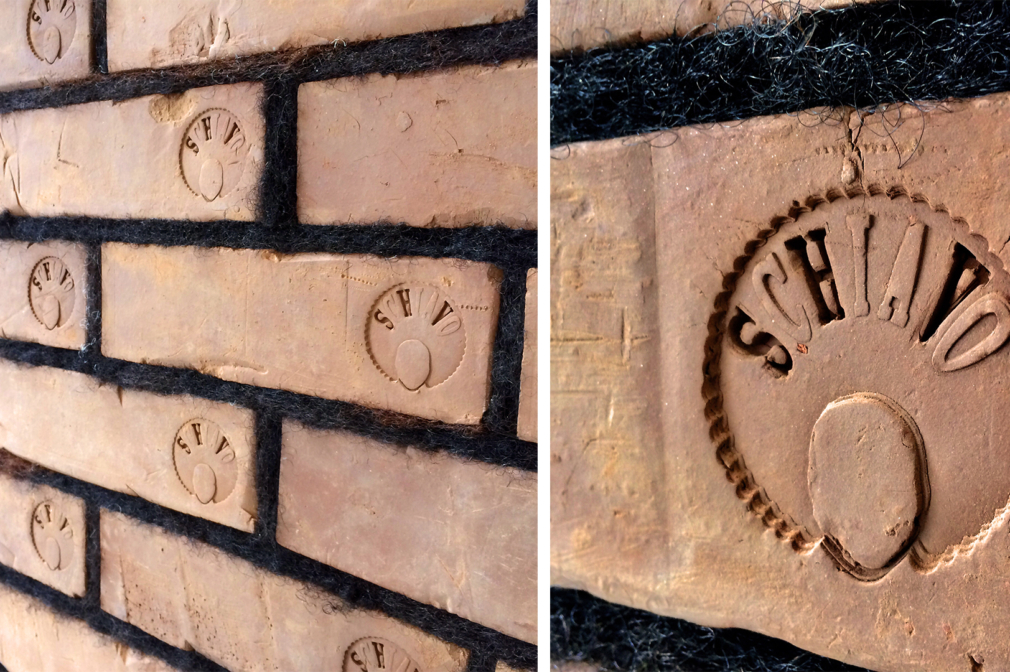Sonya Clark (based in Amherst, MA) draws from the legacy of crafted objects as a means to honor her lineage and expand notions of both “American-ness” and art. She uses materials as wide-ranging as textiles, hair, beads, combs, and sound to address issues of nationhood, identity, and racial constructs. Clark’s pieces, Abacus 1863, Counting Change, Edifice and Mortar, and Three-Fifths serve as reminders of how histories of how histories of slavery and constructions of race are built into the foundations of modern society in the United States and around the globe.

2018
Edifice and Mortar
Collection of the artist
Hand-stamped bricks, human hair, and glass

2018
Edifice and Mortar
Collection of the artist
Hand-stamped bricks, human hair, and glass
Edifice and Mortar is an eight-foot wall made of bricks. On one side, the bricks are stamped with a custom maker’s mark which features the outline of a head with an afro bearing the word schiavo, Italian for “slave.” Within schiavo the letters “c,” “i,” “a,” and “o” are raised to spell ciao, which is the Italian greeting derived from the phrase s-ciào vostro—“I am your slave.” On the other side of the wall is selected text from the United States Declaration of Independence.
The mortar for the wall is made of hair gathered from African American barber shops, binding together the promises of equality written across the bricks while drawing attention to the history of transatlantic slavery, migration, and colonialism on which the nation is built. A blue mirror leaning against the wall conjures the image of a U.S. flag, while also reflecting the viewer, inviting each individual to consider their position within this paradox.

2010
Three-fifths
Collection of the artist
Cloth and thread
In the U.S. Constitution, Article 1. Section 2. (the “Three-Fifths Clause,” ratified in 1787) declared that any person enslaved would be counted as three-fifths of a free individual for the purposes of determining congressional representation. This clause remained in place until the passing of the Thirteenth Amendment in 1865, which abolished slavery except “as a punishment for crime.”
In Clark’s Three-Fifths, three woven braids on the back of a white button-up shirt evoke nineteenth-century prison uniforms and critique the present economic and political ramifications of this legislation. Current voting laws in most states hold that individuals convicted of a felony are not allowed to vote during their sentence or while on parole, and in some cases permanently, even as they are still counted as residents for the purpose of determining representational districts.

2010
Abacus
Collection of the artist
Wood, human hair, and metal
Abacus and Counting Change refer to the Emancipation Proclamation, the presidential proclamation from 1863 which declares that all persons held as slaves “shall be then, thenceforward, and forever free.” Abacus is a sculptural work in the shape of the ancient calculating tool and featuring beads made from Clark’s hair. Counting Change, a stop motion video of Abacus in motion, is set to a soundtrack of Nina Simon’s Old Jim Crow and registers the passage of time from Emancipation Proclamation to the present: a sequence of still images show the beads of Abacus shift as they move to count the years.
Together, the works raise questions about whether emancipation has been truly achieved. As Clark states, “When the nation ended the Civil War, one of the things it had to contend with was: Are Black people going to be treated as people, as actual citizens? We are still answering that question.”
Sonya Clark’s work is also featured in the following Barring Freedom study guide: Histories & Structures
Profile

Born in Washington, D.C. to a psychiatrist from Trinidad and a nurse from Jamaica, Sonya Clark’s work draws from the legacy of crafted objects and the embodiment of skill. Clark is a full professor in the Department of Art and the History of Art at Amherst College in Western Massachusetts. From 2006 until 2017, Clark was a full professor and chair of the Craft and Material Studies Department at Virginia Commonwealth University School of the Arts in Richmond, Virginia. Formerly she was Baldwin-Bascom Professor of Creative Arts at the University of Wisconsin, Madison. She holds an M.F.A. from Cranbrook Academy of Art, and she was awarded their first mid-career Distinguished Alumni Award in 2011. She also holds a B.F.A. from the School of the Art Institute of Chicago. In 2015 she was awarded an honorary doctorate from her alma mater Amherst College where she received a B.A. in psychology. She has exhibited her work in over 350 museums and galleries in Europe, Africa, Asia, Australia, and the Americas. She is the recipient of several awards including an Anonymous Was a Woman Award; Art Prize Grand Jurors co-prize; Pollock-Krasner Grant; Smithsonian Artist Research Fellowship; Rockefeller Foundation Bellagio Fellowship in Italy; BAU Camargo Fellowship in France; a Red Gate Residency in China; Civitella Ranieri Residency in Italy; 1858 Prize for Contemporary Southern Art; United States Artist Fellowship; and Art Matters Grant. Her work is in the collections of the Philadelphia Museum of Art; the National Museum of Women in the Arts, Washington, D.C.; the Indianapolis Museum of Art; the Virginia Museum of Fine Art, Richmond; and the Musees d’Angers in France, among several other institutions. Several publications have reviewed her work including The New York Times; Philadelphia Inquirer; Forbes Magazine; Sculpture Magazine; Huffington Post; Time Magazine; Artnet News; Hyperallergic; and others.
Learn More
Suggested Reading
Agard, John
Half-Caste and Other Poems
UK ed. Edition. London: Hodder Children’s Books, 2005.
Painter, Nell Irvin
The History of White People
First edition. New York: W.W. Norton, 2010.



